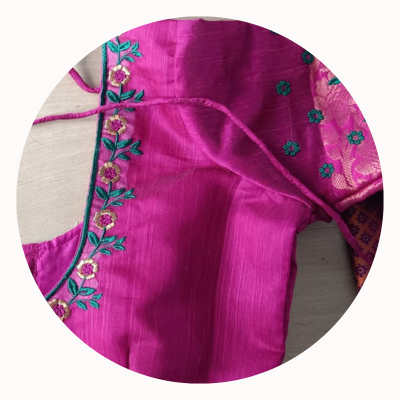If the future is female (and digital), these Indian entrepreneurs are ready
November 5, 2024 | By Sophie Hares
Struggling to make ends meet on her husband’s farming wage, Swetha YM was searching for ways to earn extra money to support her two children in the town of Pavagada, in India’s southern state of Karnataka.
After running into an old friend who owns a successful clothing business, she began learning how to customize fabrics for blouses and saris. Embellished with intricate embroidery, as well as sequins and faux gemstones, these garments are central to what marks events, such as weddings, holidays and festivals, as special in India. Before long she received a steady enough stream of orders from neighbors to launch her own business, Srideep Fashions — “srideep” meaning “beautiful light” in Hindi.

But Swetha’s neighbors could order only so many saris. So she signed up for a training program called Digital Saksham to learn how to use Facebook and Instagram to reach new clients outside of her community.
Today, she employs four women to run her small store and field orders from customers throughout neighboring states. Swetha earns around $300 a month, enough to contribute meaningfully to her family’s expenses.
“At the beginning, I didn’t know how to market my business, but the Digital Saksham training has really helped and means I can now make sure my daughter and son have a good future,” she says.
Digital Saksham — saksham translates to “able” in Hindi — is a collaboration between the Confederation of Indian Industry and Mastercard Strive, a global philanthropic initiative to digitalize small businesses. It’s part of a broader effort by the Indian government to unlock the full potential of micro and small enterprises — and part of Mastercard’s efforts to bring 50 million small businesses into the digital economy by 2025, a goal it recently met.
As Swetha experienced, accessing digital tools can help these mom-and-pop shops scale up, reach new customers and hire more employees. The increased economic activity is expected to help India continue its speedy growth toward becoming the third-largest economy in the world within three years — after being 10th just a decade ago.
Supporting women-owned businesses
But those lofty goals start with on-the-ground efforts. The Digital Saksham program began during the pandemic, training participants in digital literacy, to help them integrate into today’s economy by accessing credit, diversifying their customer base and digitaliznig their financial operations.
Since its 2021 launch, Digital Saksham has raised awareness of the benefits of digitalization for nearly 300,000 micro and small enterprises and trained more than 70,000 small businesses in 13 Indian states, often starting with the basics of how to build a digital profile before teaching ways to generate leads, accept payments and even launch online stores.
Rather than training virtually, Digital Saksham sends instructors into communities where they work with clusters of entrepreneurs in local languages. Thus far, participants have ranged from silk weavers in the northeastern state of Assam to coconut oil producers in southern state of Karnataka.
Nearly half of those participants have been women — an interesting developmen given that female entrepreneurs make up only 20% of the country’s 63 million small businesses. However, as more women hunt for ways to support their families and gain financial independence, they are following entrepreneurial paths similar to Swetha.
One of the most crucial skills these small businesses need to attain is the ability to accept digital payments via card or popular mobile phone platforms. It’s what allows the tiniest business to claim a national or even global presence, says CII Director Vivek Upadhyay. His team worked with a group of bookstore owners in Kolkata who were able to leverage their online marketing skills to now ship best-selling Bengali-language novels to the Indian expatriate community worldwide.
Digital payments take on extra importance for women entrepreneurs.
“Women have traditionally not had decision-making power over money,” Upadhyay says. “Cash meant [the men in the family] could take money and use it their own way. Now that money goes straight to the bank, which gives women more control over their income.”
Digital Saksham’s next phase will teach small businesses to use the latest AI tech to produce snappy videos and market their wares, as well as deepen their financial and digital understanding to ensure they stay afloat.
Program coordinators also want to make sure these entrepreneurs know how to protect themselves against cyberattacks, which are on the rise and could easily wipe out unprepared businesses with devastating impacts for the families those businesses help support.
In the upcoming year, the program expects even more women to sign up, and it is prepared to equip them with the tools they need to build their businesses and become financially resilient.
Although they may need to fit the training into a schedule packed with caring for children and elder family members, Swetha is urging her friends to join.
“I’ve already told other women how Digital Saksham helped me,” she says, “and hopefully it can help them too.”